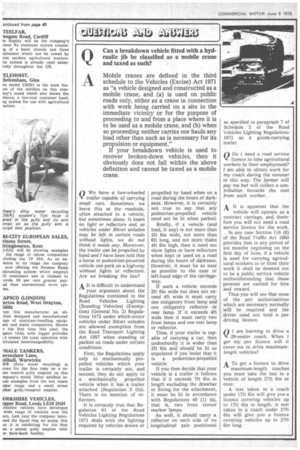Q We have a two-wheeled trailer capable of carrying small cars.
Page 44

If you've noticed an error in this article please click here to report it so we can fix it.
Sometimes we leave this at the roadside, often attached to a vehicle, but sometimes alone. It bears no light or reflectors and, as vehicles under 30cwt unladen may be left in certain roads without lights, we do not think it needs any. Moreover, the trailer can be propelled by hand and I have been told that a horse or pedestrian-powered vehicle can park on a highway without lights or reflectors. Are we breaking the law?
A It is difficult to understand your argument about the Regulations contained in the Road Vehicles Lighting (Standing Vehicles) (Exemption) (General No. 2) Regulations 1972 under which motor vehicles under 30cwt unladen are allowed exemption from the Road Transport Lighting Act 1957 when standing or parked on roads under certain conditions.
First, the Regulations apply only to mechanically propelled vehicles which your trailer is certainly not, and second, they do not apply to a mechanically propelled vehicle when it has a trailer attached (Regulation 3 (b)). There is no mention of reflectors. It is certainly true that Regulation 61 of the Road Vehicles Lighting Regulations 1971 deals with the lighting required by vehicles drawn or propelled by hand when on a road during the hours of darkness. However, it is certainly not true to say that any pedestrian-propelled vehicle need not be lit when parked. Briefly, if a vehicle (and load, if any) is not more than 2ft Gin wide, not more than 6ft long, and not more thahn 4ft Gin high, then it need not show lights or have reflectors when kept or used on a road during the hours of darkness. However, it must be as near as possible to the near or left-hand edge of the carriageway. If such a vehicle exceeds 2ft Gin wide but does not exceed 4ft wide it must carry one obligatory front lamp and one obligatory reflector or rear lamp. If it exceeds 4ft wide then it must carry two front lamps and one rear lamp or reflector. Thus, if your trailer is capable of carrying a car, then undoubtedly it is wider than 2ft 6in and should be lit as stipulated if you insist that it is a pedestrian-propelled vehicle. If you then decide that your vehicle is a trailer it follows that if it exceeds 7ft Gin in length excluding the drawbar or fitting for the attachment, it must be lit in accordance with Regulations 45 (1) (a), that is, two front corner marker lamps. As well, it should carry a reflector on each side of its longitudinal axis positioned as specified in paragraph 7 of Schedule 2 of the Road Vehicles Lighting Regulations 1971 as a goods-carrying trailer.


















































































































